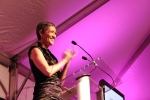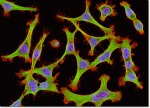I know that many of our TNBC community are living with metastatic disease, and that they often feel as though they have been “left behind” or are unable to connect with the programs and resources available to other women with breast cancer.
I thought this article presented the perspective of those who are not only living with metastatic disease, but taking care of them and advocating for them as well.
Correction Appended
By the time Suzanne Hebert realized that her doctor was wrong and that the hard lump in her breast wasn’t a normal part of breast-feeding, the tumor was the size of a stopwatch and the cancer had spread to her spine.
Still, Dr. Hebert, an optometrist in South Windsor, Conn., went to her first support group meeting thinking that as bad as things were, at least breast cancer was not an obscure disease; she would not be alone.
But the room was filled with women who had early localized cancers. Some had completed chemotherapy years ago; they were “survivors.” When one newcomer asked Dr. Hebert for her story, she couldn’t bring herself to tell the truth.
Although great strides have been made in the treatment of breast cancer, recent events, including Elizabeth Edwards’s death last month and the government’s decision to ban the drug Avastin as a treatment for metastatic breast cancer, have drawn attention to the limits of medical progress — and to the nearly 40,000 patients who die of the disease each year.
Of women who are given a diagnosis of breast cancer, only 4 percent to 6 percent are at Stage 4 at the time of diagnosis, meaning the cancer has already metastasized, or spread, to distant sites in the body. But about 25 percent of those with early-stage disease develop metastatic forms, with an estimated 49,000 new diagnoses each year, according to the American Cancer Society.
At least 150,000 Americans are estimated to be living with metastatic breast cancer — including Dr. Hebert, now 45, who got her diagnosis six years ago and now works with the nonprofit Metastatic Breast Cancer Network.
Stage 4 breast cancer can be treated, but it is considered incurable. Depending on the type of tumor, patients may live for many years — working, raising children, starting nonprofit foundations, doing yoga and even running half-marathons.
But theirs are not pink-ribbon lives: They live from scan to scan, in three-month gulps, grappling with pain, fatigue, depression, crippling medical costs and debilitating side effects of treatment, hoping the current therapy will keep the disease at bay until the next breakthrough drug comes along, or at least until the family trip to Disney World.
“This woman had just been diagnosed,” Dr. Hebert said of her support-group encounter, “and I couldn’t bring myself to tell her: ‘I have it in my bones. I have it in several parts of my body. My treatment is never going to end.’
“It was a horrible moment,” she went on. “I had nothing in common with them. I was what scared them.”
While perceptions of the disease may have changed in recent years, the number of deaths it causes has remained fairly static, said Dr. Eric P. Winer, director of the breast oncology center at the Dana-Farber Cancer Institute in Boston.
“All too often, when people think about breast cancer, they think about it as a problem, it’s solved, and you lead a long and normal life; it’s a blip on the curve,” he said. “While that’s true for many people, each year approximately 40,000 people die of breast cancer — and they all die of metastatic disease. You can see why patients with metastatic disease may feel invisible within the advocacy community.”
Many patients keep the spread of their disease private, and Mrs. Edwards’s 2007 announcement that her cancer had become “incurable” was an inspiration to many — it was also why her death was such a blow.
“She put a face on the disease,” Dr. Hebert said. “I could explain my situation to people.
“The day she stopped treatment was very emotional,” she added, “because I’ve been telling people, ‘I’m like Elizabeth Edwards.’ ”
Mrs. Edwards’s husband, the former senator and presidential candidate John Edwards, referred to her illness as a “chronic” disease, implying that it was manageable. In fact, however, the median life expectancy for patients with metastatic breast cancer is just 26 months, and fewer than 1 in 4 survive for more than five years.
But because breast cancer is a complex illness that encompasses many subtypes, generalizations are tricky. New drug treatments are keeping some patients alive for a decade or more, even after the disease has spread.
And they can enjoy a higher quality of life than patients did in the past, because treatments are better focused and have fewer side effects. The prognosis has especially improved for patients with certain aggressive cancers, like HER2-positive, that were considered extremely difficult to treat until recently.
“Over the past 20 years, we’ve had probably 15 new drugs approved by the F.D.A., and each of them adds an incremental amount to the length of life, “ said Dr. Gabriel N. Hortobagyi, director of the breast cancer research program at M. D. Anderson Cancer Center in Houston.
The average patient may receive eight or 10 different treatment regimens in sequence, he said.
“I would never tell a patient with a newly diagnosed metastasis that there is nothing I can do,” he said, “because there are actually dozens of things I can do — whether it is hormone therapy, whether it is Herceptin, whether it is irradiation therapy or single-agent chemotherapy — and there are many things we can do to control symptoms and prevent complications.”
But treatment at these advanced stages is an art as well as a science, involving “a certain amount of trial and error,” said Dr. James L. Speyer, director of the Cancer Center at N.Y.U. Langone Medical Center. “You try a treatment, based on your best knowledge about the patient and the features of the cancer, and if it’s working, great — you continue it unless the side effects are a problem,” he said. “And if it’s not working, you stop and try again.”
Patricia McWaters, who lives in Missouri City, Tex., a suburb of Houston, had frequent mammograms but did not learn she had breast cancer until it appeared in her liver and spine in 2003. Now 71, she has had nine treatments at M. D. Anderson, including combination chemotherapy, drugs that block estrogen production, more chemotherapy followed by a chemo drug that comes in pills, and now a new, more aggressive drug. “Whenever anything quits working and a spread is starting, then we change,” she said.
In some cases, metastatic breast cancer appears to go into long-term remission, but experts say that in most cases it will recur, eventually becoming resistant to all treatment.
Since it is metastasis that ultimately kills, some advocates want more resources devoted to its study and treatment. Even though many cancer drugs are initially tested on patients with advanced disease, Danny Welch, an expert on metastasis, says only a few hundred scientists in the world are trying to understand the process.
“It’s responsible for 90 percent of the morbidity and mortality, but gets less than 5 percent of the budget,” said Dr. Welch, a senior scientist at the Comprehensive Cancer Center at the University of Alabama at Birmingham, who studies genes that suppress metastasis. (Those genes are turned off when cancer is advanced.) “Funding agencies as a rule want to say their research portfolio is successful — they want a return on their investment very quickly.”
Patients with metastatic disease are frustrated because they are often barred from clinical trials if a certain number of chemotherapy regimens have failed to work for them.
When they find a drug their tumor responds to, they can achieve a remarkable degree of stability. Pat Strassner, 61, of Severna Park, Md., had breast cancer that spread to her lung and hip in 2007, but she has had success with a chemo pill called Xeloda for the past three years. The drug has side effects, including drying out the skin on her hands and feet so much that they crack and bleed, but Ms. Strassner is still able to enjoy running, and last month she completed a half-marathon with her husband in Charlotte, N.C.
Other drugs are proving more problematic. Last month the Food and Drug Administration announced that it was withdrawing approval for Avastin in metastatic breast cancer after four studies found that it did not prolong survival and led to life-threatening risks, including heart attack and heart failure.
Christi Turnage, 48, of Madison, Miss., who has been using Avastin for two and a half years, said she was terrified about losing access to it. “This drug is literally keeping me alive,” she said.
This kind of uncertainty keeps many patients from throwing themselves wholeheartedly into the ethos of hope and empowerment that helps sustain many women with less aggressive forms of the disease.
Dr. Hebert says that while the pink-ribbon campaign has raised awareness about breast cancer, it masks a relentless killer.
“People like the pretty story with the happy ending,” she said. “We don’t have the happy ending.
“You always hear stories about women who ‘battled it’ and ‘how courageous’ they were. Cancer doesn’t care if you’re courageous. It’s an injustice to all of us who have this. There are women who are no less strong and no less determined to be here, and they’ll be dead in two years.”
Correction: January 18, 2011
Because of an editing error, an article on Tuesday about metastatic breast cancer referred imprecisely to government action on the drug Avastin. The Food and Drug Administration moved in December to revoke its approval of the drug as a treatment for breast cancer; it did not decide to ban the drug for breast cancer, and doctors will still be allowed to prescribe it.
 know her through her work as a tireless advocate for triple negative breast cancer, since her diagnosis almost 2 years ago. Jennifer has brought new visibility to the TNBC cause through her many appearances, her blog and her determination to spread awareness. We were honored to honor her with the Champion Award!
know her through her work as a tireless advocate for triple negative breast cancer, since her diagnosis almost 2 years ago. Jennifer has brought new visibility to the TNBC cause through her many appearances, her blog and her determination to spread awareness. We were honored to honor her with the Champion Award!


 Posted by Elizabeth Woolfe
Posted by Elizabeth Woolfe 
 Keith Negley
Keith Negley Marilynn K. Yee/The New York Times
Marilynn K. Yee/The New York Times